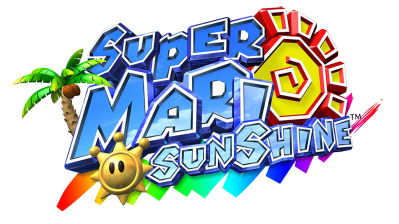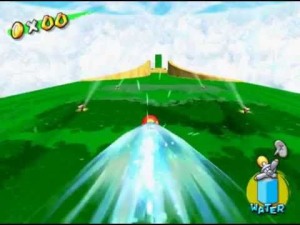The Nintendo Lunchbox, er, Gamecube, was always a system that defines a certain aspect of my history of playing games – the break-up. After a bit of time with a Gamecube as a child, our family got a PS3, which was all new and shiny and not a lunchbox. So I sold the Gamecube. I didn’t feel too attached to it, or at least in light of the newer, grander PS3; but as time went by I had surprisingly fond memories of the system and this game. After a long time, I re-bought both. I always felt like I had let it down, ditching it without giving it a fair shake.
So, when I replayed it for the first time, much like the waves crashing on Sirena Beach, the nostalgia of it all came back. FLUDD, even, felt like a long-lost friend. All of the cheery feelings came together like a delicious watermelon smoothie, and it was wonderful. Except, there were a few things different this time around.
There were a few raindrops, thumping ever-so-softly on the cabana roof that kept reminding me that paradise wouldn’t exactly be found here. At its core, Super Mario Sunshine is one of the most inventive and atmospheric Mario games of the current millennium. But, there are times where the inventiveness falters and becomes a blemish on the otherwise pristine skies.
There are a lot of criticisms surrounding this game, from different angles. FLUDD, voice acting, the general strange vibes, whatever freakish organisms the Piantas are, etc. Most of these are overblown complaints; if you can’t bear to hear the cutscenes, mute the sound; if you’re weirded out by the strange vibes, what are ya doin’ in the Mushroom Kingdom? It comes with the territory. But, the one legitimate criticism is centered in the inclusion of FLUDD.
And, no, I don’t think FLUDD is the worst thing to happen to Mario since he got hit in the face with Donkey Kong’s barrels. Mostly, FLUDD is a great variant to the platforming of Mario: rather than moving Mario in the 8 directions of Mario 64, Mario can jump, hover forward, turn, and hover left and land around a previously unavoidable corner. Add the nozzle upgrades, and you have a range of motion and speed completely new to the series.
But, why ruin that core concept by making a level where you have to push a watermelon down a hill? Why would you make the player race on a blooper that’s impossible to dismount? The main issue with Sunshine is that it ditches its soul too often, forcing the player to rely on sometimes unreliable physics and controls to get through certain stages. For most of the game, the wide array of moves Mario is given feel smooth and easy to control; it’s fun to clear The Caged Shine Sprite in around a minute because Mario is so smoothly moved up the scaffolding. On the other hand, the Pachinko level is as reliable as the constantly-asleep student is at turning assignments in on time. It may work out once in a blue moon, but too often it feels out of the players’ control.
The game is built around the idea that Mario is sentenced to clean the island, and for a while, he does. He scrubs like an obedient little plumber, although the fact that pipes are mostly absent makes me wonder why the judicial system believed this was the best service Mario could perform. Thankfully, the game abandons both the introductory mission and the monotonous cleaning of surfaces. Because Mario: Windex Edition would have been awful. So, it’s in these new gameplay opportunities Mario Sunshine should shine the most, and they more often than not do.
One of the most enjoyable parts of Mario Sunshine is, ironically, the levels that do not have FLUDD. These both make the player understand how much they relied on the jetpack in the game and run Mario through his old routines. It’s the best of both worlds, and makes both parts of the game feel fresher than they would have as separate games. These secret levels, along with the ones that do allow FLUDD usage, provide a simple objective that is completed solely by mastering the mechanics. No outside forces, or icky, paint-like goop. Just the plumber and his roots.
These have a downside, though. Each secret level has a red coin missions for a star. There is no particular reason for the sheer amount of these levels. No one was pining for more red coin missions, at least to my knowledge. I am absolutely fine with the eighth mission in each world being a red coin mission, as it is in most of the worlds. These give a nice wrap-up of the levels and are a good inclusion, since the levels themselves are a joy to be in. The Secret Mission red coins, however, replace any real effort for more valuable content. Once the player realizes many of the Shine Sprites are gained in levels they have already played, it takes the wonder out of the experience. A new island locale would have been greatly appreciated. Perhaps something that integrates the mountain that’s visible at most parts of the game, or another little village of Nokis not obsessed with shoving Mario into a little bottle.
More annoying than the red coins are their blue counterparts. I am actually a big fan of them on a surface level – they encourage exploration of the worlds and provide incentives for paying attention to the details of the level design. But, 240 of them? It’s twice as tedious as the Gold Skultullas in Ocarina of Time, and extremely frustrating in levels like Noki Bay, where falling from the crevices means Mario will take 3 minutes to reach the spot you were at again. Remembering all of their locations is a task left to only the craziest or most gifted of players.
Then there’s the litany of bad missions. The Secret of the Village Underside from Pianta Village comes to mind immediately. Mario is all about platforming and sublime controls. This mission completely removes both from the player’s control. Why should my ability to get a Shine Sprite be based on where I stand and which weird Pianta I talk to? That negates everything Mario is fun for. Then there’s the already-mentioned Watermelon Festival, which is a leap and a prayer that those Cataquacks don’t bust your prize watermelon and sabotage your chances of getting a star.
Yoshi also gets the short end of whatever stick Mario casts lots with. While the fact he’s present is welcome, and the color-changing depending on the fruits he eats is a nice feature, he is not utilized well. His allergy, which is a gross understatement, to water is odd. I wasn’t aware he had such a problem with swimming before, and to watch him dematerialize for touching the stuff is a cruel end to his life. He is also not used for many missions, with only 2 requiring him for progression. If a gameplay mechanic is going to be added, expand its usage.
Of course, I didn’t remember these things when I bought the game that second time. Sure, I remember the existence of the lesser levels. Sure, I remembered the tedium of the coin collecting stages. And, in the future, I may once again forget about those things. For now, I will still hold this game in my good graces, albeit with some very major complaints about some of its design choices. Many of the most promising elements are underdeveloped or overdone, making the experience feel as if something is missing. Perhaps it’s too foreign-feeling to truly work perfectly. I can’t be sure.
But, at least that watermelon smoothie tastes amazing most of the time. I can’t really argue with that.


